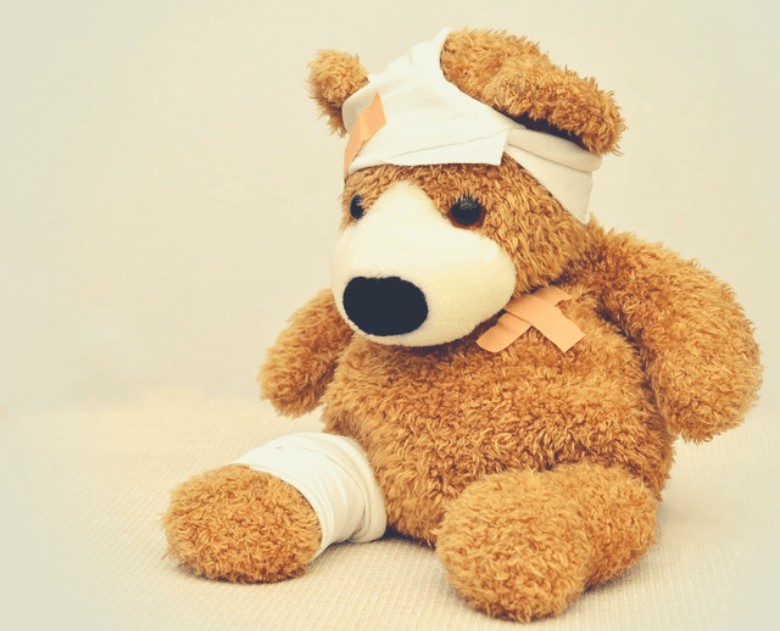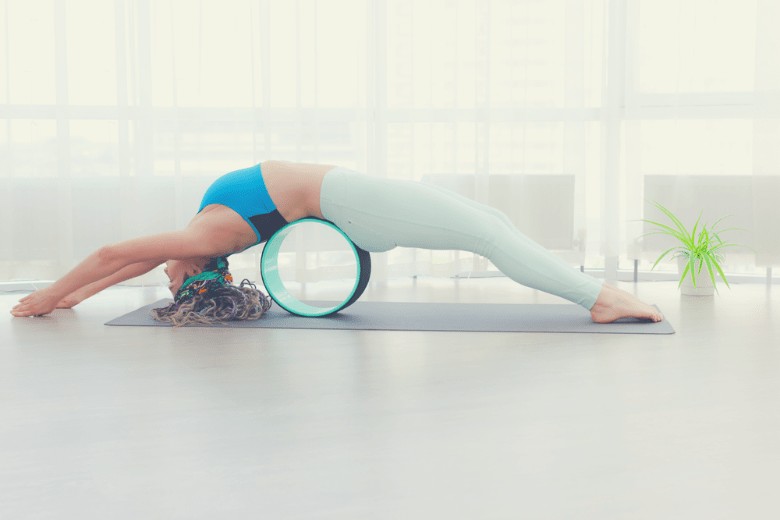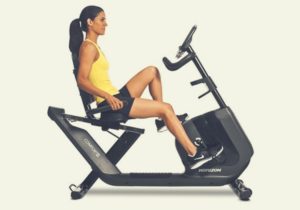Morning jogs have always been important to me. However, the routine caused me great discomfort when I couldn’t perform properly throughout the day because of lower back tightness, and sometimes immense pain.
I realized there are certain things I was overlooking, especially properly warming up before running.
I formed the habit of massaging my back to relieve the discomfort, and came to learn about a piece of fitness equipment called a yoga wheel.
Read on for more of my experience as a runner dealing with lower back pain using a yoga wheel.

Lower Back Tightness and Pain
Lower back tightness, or pain, is physical discomfort in your lumbar region, and it can range from mild to severe, depending on the cause.
Causes of Lower Back Stiffness
Common causes of back problems are trauma, damage, and wear of muscles, bones, and tissues in your back and spine.
You can experience tightness in your lower back because of an injury, like a hamstring and sciatica, among others.
It can also be caused by poor posture, uncomfortable resting surfaces, tight hip flexors, heavy lifting, chronic illnesses, spine inflammations, dehydration, or poorly performed exercises.
Running, specifically, can cause serious lower back discomfort and is a common problem among professional and amateur athletes.
Symptoms of Lower Back Tightness
If you have a tight lower back, you probably have difficulties with movement, and you can’t even lift something off the ground.
This tightness can, at times, be accompanied by pain, spasms, or cramps. The pain can be a constant dull ache, and your back will feel stiff and contracted.
The tightness sometimes spreads to the pelvis area, hips, or even legs.
In most cases, if lower back stiffness is a result of strenuous workout or heavy weightlifting, it goes away after enough rest, without the need for serious treatment.
Running And Your Lower Back
Running, or jogging, is one of the most performed exercises in the world, not only by professional athletes but also by fitness enthusiasts.
It is for good reason you love running; it is a full-body workout that strengthens your muscles, improves your cardiovascular fitness, reduces weight, and improves your physical fitness.
Studies have shown the benefits of running, among them significantly increasing longevity.
When you run regularly, you increase your lifetime by at least three years and reduce the risk of premature mortality by 25% to 40%.
How Long Should You Run Per Day?
Running has excellent benefits for your health. According to this study, a moderate run of 5 to 10 minutes can greatly improve your chances against a heart attack, stroke, cancer, and even neurological disorders like Alzheimer’s and Parkinson’s disease.
Running is also attributed to improved cognition in aging brains.
While it is okay to run daily, this research shows that if you run a total of 2.5 hours a week, or in simpler terms, 30 minutes daily for five days, you can yield the maximum benefits to your health and longevity.
The American Council on Exercise (ACE) emphasizes the importance of rest days according to your workout plans, and your recovery rate.
It is important to note that the body requires time to recover after a run, which is different for every person.
While running daily might increase your longevity and help you keep deadly diseases at bay, it may also encourage injuries.
Generally, runners are advised to rest for at least a day in a week to allow their bodies to recover.
How Can Running Cause Lower Back Tightness?
Because running is a high impact sport, it can cause many unforeseen problems. You might expect to only be out of breath, or your legs weakened, or just general exhaustion.
The one consequence you might not expect is lower back pain or tightness.
There are several reasons you might feel this tightness when you run. The main culprit can be you are not in form, or your muscles are simply not strong enough to support such a strenuous activity.
Lower back pain, during or after a run, can be debilitating and even demoralizing. I realized that I was not very flexible when I suffered from back pain during my runs.
This fact, then, meant my body wasn’t ready for the strenuous running I was doing.
I simply could have started small and built momentum with time. But because I love running, and wanted fast results, I did not take time to let my body guide me.
Let me show you why your back hurts when you run and what you should do to prevent it from happening in the future.
When running, a lot of your muscles work together to support you. These muscles need to be in good shape, healthy, and resilient if they work together.
These are mostly muscles located in your lumbar region, which starts from below the ribcage, down to your upper buttocks. Other muscles are attached to your hips, glutes, and hamstrings.
If some of these muscles can’t handle the pressure, other muscles step in to do the job, which means some are overcompensating.
This overcompensation is what leads to wear and tear, and eventually injury and strains.
When running, it is your lower back that offers you the most support. It is because most of the muscles involved in the run are attached to the spine, and the spine provides stability and flexibility to facilitate your movement.
Lower back tightness and pain experienced from running emanates from some of these muscles not working properly, which then injures the ones that step up.
How Can You Prevent Lower Back Tightness When Running?
The best way to prevent lower back tightness when running is first to know why it is happening. Are you running for too long?
Did you get injured without knowing? Is it the way you run?
Sometimes you might not pay a lot of attention to the way you run, and maybe it is your stride that is causing you discomfort. In my case, I suffered a lot because of the way I ran.
If this is the case, you might want to train yourself in a new walking and running style. I did the same; I made shorter and faster strides. Doing this will ensure you avoid irregular twisting that can cause injury.
It is also wise to reduce the amount of time you run once you start hurting, and as well, maybe change the path you run on.
If it’s rough, you are probably struggling without knowing, and this can have severe repercussions.
When you figure out why your back is tightening, you need to make changes to your routine to stop hurting yourself. The next thing is to take measures to alleviate the pain or tightening.
There are several ways you can do that; you can take an extended break to heal correctly, seek medical help, and undertake various therapeutic measures.
If your lower back is tightened from running and you know why, I recommend using a yoga wheel as therapy. It can help you loosen those tight muscles and get you back running in good time.
But first, what is it, and how can it relieve the lower back tightness?
What is a Yoga Wheel?
For over 5000 years, yoga has been practiced in India and beyond as a practice that combines physical stretches, breathing techniques, and relaxation techniques to help a person achieve physical, mental, and spiritual fitness.

It is a practice that enables muscle strengthening, flexibility, and stability. Now, for people who don’t exercise a lot, yoga can be a bit overwhelming.
It requires some experience and discipline to perfect.
When doing yoga, you physically stretch muscles in your body, especially around the lumbar region and legs. These are crucial for relieving lower back pain and stiffness.
Many people join yoga classes or start practicing yoga because the poses and stretches involved are right for their overall health; they are also very remedial to back problems.
For those without the stability, flexibility, and experience required to help them alleviate lower back discomfort through yoga, a piece of equipment has been invented that can help. It is called the yoga wheel.
It is a hollow, circular, wooden, or plastic yoga accessory that is malleable to help you perform vital stretches on. It measures up to 15 inches in diameter and is either 5 or 6 inches wide.
How Can a Yoga Wheel Help You Relieve Back Tightness And Pain?
With this wheel, you have the support you need to perform the yoga poses to help reduce or eliminate lower back discomfort.
The wheel, also, as you stretch on it, deeply massages your back, targeting your vertebrae and surrounding muscles.
This massage has been lauded by many as practical as seeking medical and professional massage services.
It helps when you perform these stretches on the wheel, to observe your breathing. It is crucial to be as calm as possible to complete the stretches the best way you can, and this means you loosen all the tight muscles causing you discomfort.
The best yoga poses for back pain relief require experience. However, the wheel gives you an advantage over that because it supports you, thus allowing you to perform some advanced stretches.
When you experience back pain, you have likely twisted muscles in your back, and to heal, these need realigning.
Osteoperosis and spinal stenosis are common causes of lower back pain in seniors and may benefit from a yoga wheel for back pain they are experiencing.
Injuries, strains, poor posture, and other factors lead to immense pressure on the spine, causing pain and, at times, even paralysis.
It is where the wheel comes in because it is designed to help you realign your spine. Naturally, the spine has an s-curve, and this is why the wheel has that circular design to adjust to this curve.
All you do is stretch on it, and as it massages your back and you stretch, your spinal cord gets realigned to the state that won’t hurt.
Yoga wheels offer great support, but it is essential to ensure you use it the right way not to accelerate an existing injury or cause a new one.
As said before, it takes some time to perfect the practice of yoga. Therefore, it means that you need to be cautious with the stretches you attempt with the wheel. It is round, and as such, can easily cause an unwanted accident.
Some Exercises You Can Perform on a Yoga Wheel to Relieve a Tight Lower Back
These exercises can help alleviate the adverse effects running can pose to your lower back.
As said before, there are various ways running can cause you discomfort, and loosening muscles in your lower back, using the wheel, can ensure you get back to running as soon as possible.
To effectively massage your back, carefully lay on the wheel and slowly roll up and down, throughout your spinal column. Any pose you can do with your back on top of the wheel, you can manipulate careful motions to get a massage.
Stretching your back and the whole body is a great way to enable stability and flexibility when you resume running.
The hindrance to your running benefits is that you are sometimes not as flexible as you need to be.
So, to eliminate the hindrance, use the wheel carefully, even with guidance from an instructor, to perform these exercises, low lunge, reclining butterfly pose, and the reclining hero pose.
With a wheel, you can perform exercises that target the glutes, upper body, core, and other areas that will improve your balance, strength, and flexibility.
These exercises will help you stay in form when running and effectively eliminate back pain and tightness.
Yoga Wheel Buying Guide
As we have established, this wheel can easily make your running more enjoyable and beneficial.
It will strengthen and massage your tight muscles, help you with the challenging yoga poses, and help you improve your stability and flexibility when you want to run, or even hike.
What, then, do you want to look for when buying a yoga wheel?
The first thing you want to get right is the size. The larger the wheel, in diameter and width, the better support it will give you.
It is vital to countercheck the size of the wheel with your height and weight to make the best choice.
The second thing is the design. You might wonder what I mean by design since the wheel is round and hard enough to stretch on. Different wheels offer different benefits.
The design determines the effectiveness, comfort, quality, and even price in some cases, among other factors.
When buying a wheel, you want to get the best deal, a wheel you will not struggle to use, and a wheel that will not cause you an injury.
For instance, the Chirp Wheel is FDA-registered as a 501(k) medical device and is the only wheel with a spinal canal.
It is specifically designed to realign your spine; it perfectly fits your back and is made of strong and durable material to guarantee comfort and support for the best results.
> > Check out our full Chirp Wheel Review < <
Final Thoughts
Running has its benefits but, overdone or done the wrong way can have grave consequences.
You need to know why running is causing you trouble, and once you do, decide whether or not you should use the wheel.
With the right amount of information on how to use the wheel, it is a great tool to relieve pain, tightness, or discomfort in your lower back.
It is crucial to know when, why, and how to use the wheel. Used the wrong way, the wheel can significantly inconvenience you; it can cause or aggravate an injury.
I continue to use a yoga wheel under my instructor’s guidance, and it has immensely helped me adjust my running in terms of time, style, and distance.
I no longer feel any tightness; I have only improved my workouts.
If you suffer from lower back discomfort from running, consult your doctor or instructor, and get all the guidance you need on using a yoga wheel.




